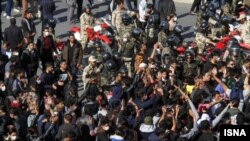More than 10 days after Iranians took to the streets in protest to a sudden gasoline price hike, the Iranian government is still overwhelmed by the aftereffects of the unrest and its violent suppression by security forces.
In the meantime, fresh videos of the violent suppression have been uploaded on social media following partial restoration of internet service which has been cut off for about a week to conceal use of lethal force by security forces from the watchful eyes of international human rights organizations and world media.
One of the latest videos shows security forces attacking a man in the head with an axe before shooting him three times at point blank range.
Another video shows a young man presumably lying dead in his blood as security forces chase protesters in a street.
Although landline internet appears to have been reconnected, most people in Iran who have access to the net only through their cell phones still remain disconnected.
In the meantime, Alireza Adyani, a cleric who is in charge of the police's political and ideological department, says IRGC and the Basij militia entered the scene to suppress the protests on Sunday November 17 after the police failed to restore order in the streets during the first two days of the protests.
He said the situation came under control within 72 hours. Previously IRGC Deputy Commander Ali Fadavi had said: "We had a war for 48 hours."
According to Iranian officials the protests were quickly turned into political turmoil as demonstrators chanted slogans against the Islamic Republic and its leader Ali Khamenei demanding his removal or death.
Security officials say that protest have rocked 28 of Iran's 31 provinces.
Adyani further said that 182 protests leaders who were linked to the Iranian opposition and Saudi Arabia have been arrested. No evidence has been presented to prove these claims. Cautious estimates by Radio Farda puts the number of those killed at 138 and those arrested during the protests at around 4800.
Meanwhile, Hassan Khalilabadi, Chief of the local council in Shahr-e Rey, south of Tehran has said that not only prisoners, but even wardens and other prison staff are living in extremely difficult conditions at Fashafouyeh Prison in the area.
Prosecutor-General Mohammad Jafar Montazeri had said November 24 during a visit to prison that "Prisoners are happy about their situation in jail," adding that they had a chance to make phone calls to their families.
In another development, IRGC spokesman Ramazan Sharif has said that that the Iranian government propaganda has been defeated by foreign-based media's propaganda about the enviable living condition in Iran under monarchy, before 1979.
Some protestors during recent and previous protests chanted slogans in support of monarchy. This comes while the Islamic regime has been mudslinging against the royal family for 41 years now.
Sharif said during a speech in Kerman that foreign based media "create contents" to glorify the Pahlavi dynasty in the minds of Iranian youth. He was possibly referring to documentaries aired on London-based TV channels to mark the 100th birthday of Shah Mohammad Reza Pahlavi whose reign ended with the 1979 Islamic revolution.
Ironically, when Iran's state TV shows footage of life in Iran under monarchy to smear the royal family, viewers often appreciate the quality of life in Iran at the time and the Shah's expertise in international affairs.
According to Sharif, the Iranian youth are beginning to doubt the Islamic regime's version of Iran's modern history.
Last week, Khamenei said during a speech about the unrest that the royal family and the outlawed Mojahedin-e Khalq (MeK) have played a part in instigating the upheaval against the regime.
The MeK was not observed to respond to Khamenei, but the Shah's widow, Farah Pahlavi, said in an interview with Radio Farda, "Khamenei should think about what prompted people to protest in the first place."
Prince Reza Pahlavi characterized Khamenei's speech as "cowardly," and said the protestors' support for the Pahlavi dynasty was a call made for reviving Iranians' welfare and Iran's pride."
Meanwhile, while all videos released so far show security forces shooting the protestors, the IRGC spokesman claimed that "people were shooting each other."






